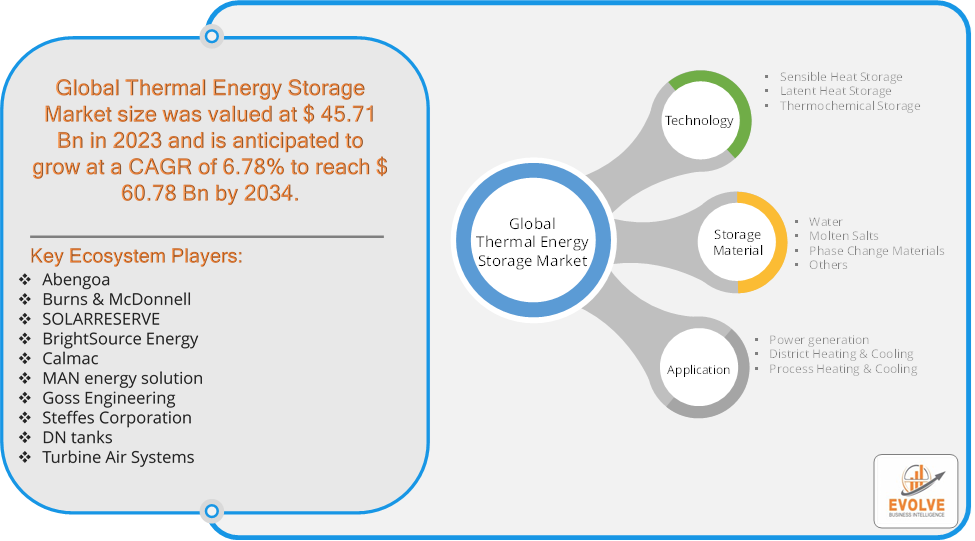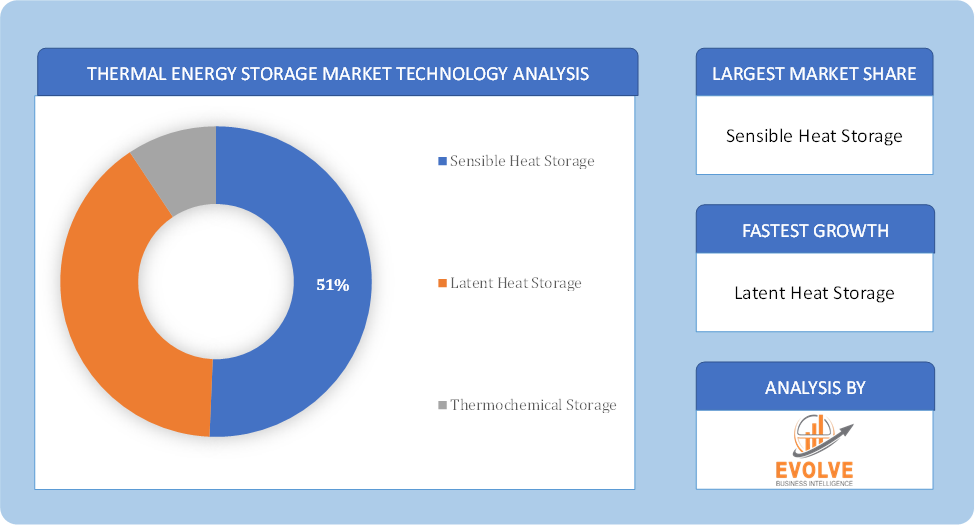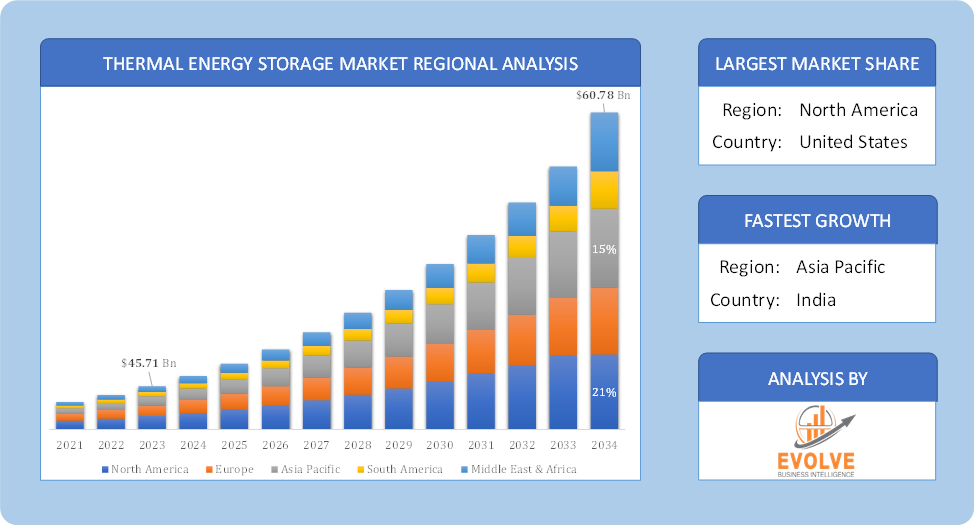Thermal Energy Storage Market Analysis and Global Forecast 2021-2034
$ 1,390.00 – $ 5,520.00Price range: $ 1,390.00 through $ 5,520.00
Thermal Energy Storage Market Research Report: By Technology (Sensible Heat Storage, Latent Heat Storage, Thermochemical Storage), By storage material (Water, Molten Salts, Phase Change Materials, Others), By Application (Power Generation, District Heating & Cooling, Process Heating & Cooling), and by Region — Forecast till 2034
Page: 175
Thermal Energy Storage Market Overview
The Thermal Energy Storage Market size accounted for USD 45.71 Billion in 2023 and is estimated to account for 46.58 Billion in 2024. The Market is expected to reach USD 60.78 Billion by 2034 growing at a compound annual growth rate (CAGR) of 6.78% from 2024 to 2034. Systems that store thermal energy for later use, providing greater energy management and efficiency, are part of the Thermal Energy Storage (TES) market. Sensible heat storage, latent heat storage, and thermochemical storage are the three main types of TES technology. These systems are widely used in many different applications, such as building cooling systems, industrial operations, and district heating. The industry is driven by the need for grid stability, energy saving programs, and the growing need for renewable energy sources. Lower energy prices, peak load shifting, and improved integration of sporadic renewable energy sources are some of the main advantages of thermal energy storage. The TES market is anticipated to increase greatly in the upcoming years as governments and companies place a greater emphasis on sustainability.
Global Thermal Energy Storage Market Synopsis
 Global Thermal Energy Storage Market Dynamics
Global Thermal Energy Storage Market Dynamics
The major factors that have impacted the growth of Thermal Energy Storage are as follows:
Drivers:
⮚ Technological Advancements
Innovation in the market is being driven by ongoing research and development in thermal energy storage technologies. Phase change materials (PCMs) and improved insulation are two examples of improved materials that increase the capacity and efficiency of TES systems. These developments improve the performance and dependability of TES solutions, increasing customer attractiveness. lower energy costs, peak load shifting, and improved integration of sporadic renewable energy sources are some benefits of thermal energy storage. The TES market is anticipated to increase greatly in the upcoming years as governments and companies place a greater emphasis on sustainability.
Restraint:
- High Initial Capital Costs
The significant upfront cost of installing TES systems is one of the main obstacles preventing their broad implementation. Even while prices have been dropping recently, advanced TES technologies can still be expensive up front, especially for large-scale installations. This may discourage possible investors and restrict smaller companies’ or projects’ access to the market.
Opportunity:
⮚ Growing Demand for Renewable Energy Integration
The global transition towards renewable energy sources, particularly solar and wind, presents a unique opportunity for TES. As these sources are intermittent, the ability to store excess thermal energy during peak production times is crucial for ensuring a reliable energy supply. TES systems can effectively balance energy supply and demand, making them invaluable in energy grids increasingly dominated by renewables. This integration not only enhances grid stability but also maximizes the utilization of clean energy, contributing to sustainability goals.
Thermal Energy Storage Market Segment Overview
Based on the Technology, the market is segmented based on Sensible Heat Storage, Latent Heat Storage, Thermochemical Storage. Sensible Heat Storage typically dominates, primarily due to its established technology, lower costs, and widespread application in various industries, including district heating and industrial processes. This method is favored for its simplicity and efficiency in storing thermal energy using materials like water and concrete.
By Storage Material
Based on the Storage Material, the market has been divided into Water, Molten Salts, Phase Change Materials, Others. Water segment generally dominates due to its cost-effectiveness, availability, and efficiency as a storage medium for a variety of applications, including district heating and cooling systems. Water-based systems are widely utilized for their simplicity and reliability in storing thermal energy.
By Application
Based on Application, the market has been divided into Power Generation, District Heating & Cooling, Process Heating & Cooling. District Heating & Cooling segment typically dominates due to its widespread application in urban areas for efficient energy management and the growing demand for sustainable heating and cooling solutions. This segment benefits from the integration of renewable energy sources and government initiatives promoting energy efficiency.
Global Thermal Energy Storage Market Regional Analysis
Based on region, the market has been divided into North America, Europe, Asia-Pacific, the Middle East & Africa, and Latin America. The area of North America is anticipated to dominate the market for the usage of Thermal Energy Storage, followed by those in Asia-Pacific and Europe.
 Thermal Energy Storage North America Market
Thermal Energy Storage North America Market
North America dominates the Thermal Energy Storage market due to several factors. The thermal energy storage market in Europe was valued at USD 11.58 billion in 2021 and is anticipated to increase at a substantial compound annual growth rate (CAGR) throughout the course of the study. Numerous thermal energy storage devices, which are utilized for power generation, district heating and cooling, water heating, and space heating, are characteristic of the area. In addition, the thermal energy storage market in Germany had the most market share, while the thermal energy storage market in the UK had the highest rate of growth in the European Union.
Thermal Energy Storage Asia Pacific Market
The Asia-Pacific region has been witnessing remarkable growth in recent years. From 2022 to 2030, the thermal energy storage market in Asia-Pacific is anticipated to develop at the fastest compound annual growth rate (CAGR). The primary drivers of regional progress are the quick development of renewable energy sources and growing investments in ecologically friendly cooling technologies. Furthermore, the thermal energy storage market in China commanded the most market share, while the thermal energy storage market in India grew at the quickest rate in the Asia-Pacific area.
Competitive Landscape
The competitive landscape includes key players (tier 1, tier 2, and local) having a presence across the globe. Companies such as Abengoa, Burns & McDonnell, SOLARRESERVE, BrightSource Energy, and Calmac are some of the leading players in the global Thermal Energy Storage Industry. These players have adopted partnership, acquisition, expansion, and new product development, among others as their key strategies.
Key Market Players:
- Abengoa
- Burns & McDonnell
- SOLARRESERVE
- BrightSource Energy
- Calmac
- MAN energy solution
- Goss Engineering
- Steffes Corporation
- DN tanks
- Turbine Air Systems
Key development:
August 2021: A new prototype technology for thermal energy storage was introduced by researchers at the National Renewable Energy Laboratory, US. This system uses silica sand as the storage medium. The cost-effective storage medium is a new technology that can be installed in small modular structures in many nations to supply heat and electricity.
Scope of the Report
Global Thermal Energy Storage Market, by Technology
- Sensible Heat Storage
- Latent Heat Storage
- Thermochemical Storage
Global Thermal Energy Storage Market, by Storage Material
- Water
- Molten Salts
- Phase Change Materials
- Others
Global Thermal Energy Storage Market, by Application
- Power generation
- District Heating & Cooling
- Process Heating & Cooling
Global Thermal Energy Storage Market, by Region
- North America
- US
- Canada
- Mexico
- Europe
- UK
- Germany
- France
- Italy
- Spain
- Benelux
- Nordic
- Rest of Europe
- Asia Pacific
- China
- Japan
- South Korea
- Indonesia
- Austalia
- Malaysia
- India
- Rest of Asia Pacific
- South America
- Brazil
- Argentina
- Rest of South America
- Middle East & Africa
- Saudi Arabia
- UAE
- Egypt
- South Africa
- Rest of Middle East & Africa
| Parameters | Indicators |
|---|---|
| Market Size | 2034: USD 60.78 Billion |
| CAGR (2021-2034) | 6.78% |
| Base year | 2023 |
| Forecast Period | 2021-2034 |
| Historical Data | 2021 (2017 to 2020 On Demand) |
| Report Coverage | Revenue Forecast, Competitive Landscape, Growth Factors, and Trends |
| Key Segmentations | Technology, Storage Material, Application |
| Geographies Covered | North America, Europe, Asia-Pacific, South America, Middle East, Africa. |
| Key Vendors | Abengoa, Burns & McDonnell, SOLARRESERVE, BrightSource Energy, Calmac, MAN energy solution, Goss Engineering, Steffes Corporation, DN tanks, Turbine Air Systems |
| Key Market Opportunities | · Huge demand for thermal energy storage in CSP |
| Key Market Drivers | · Growing government initiatives for thermal energy storage system Increasing demand for thermal energy storage in HVAC |
REPORT CONTENT BRIEF:
- High-level analysis of the current and future Thermal Energy Storage market trends and opportunities
- Detailed analysis of current market drivers, restraining factors, and opportunities in the future
- Thermal Energy Storage market historical market size for the year 2022, and forecast from 2021 to 2034
- Thermal Energy Storage market share analysis at each product level
- Competitor analysis with detailed insight into its product segment, Government & Defense strength, and strategies adopted.
- Identifies key strategies adopted including product launches and developments, mergers and acquisitions, joint ventures, collaborations, and partnerships as well as funding taken and investment done, among others.
- To identify and understand the various factors involved in the global Thermal Energy Storage market affected by the pandemic
- To provide a detailed insight into the major companies operating in the market. The profiling will include the Government & Defense health of the company’s past 2-3 years with segmental and regional revenue breakup, product offering, recent developments, SWOT analysis, and key strategies.
Frequently Asked Questions (FAQ)
What is the study period of this market?
The study period of the global Thermal Energy Storage market is 2021- 2034
What are the 10 Years CAGR (2021 to 2034) of the global Thermal Energy Storage market?
The global Thermal Energy Storage market is growing at a CAGR of ~6.78% over the next 10 years
Which region has the highest growth rate in the market of Thermal Energy Storage?
Asia Pacific is expected to register the highest CAGR during 2021-2034
Which region accounted for the largest share of the market of Thermal Energy Storage?
europe holds the largest share in 2023
Major Key Players in the Market of Thermal Energy Storage?
Abengoa, Burns & McDonnell, SOLARRESERVE, BrightSource Energy, Calmac, MAN energy solution, Goss Engineering, Steffes Corporation, DN tanks, Turbine Air Systems
Do you offer Post Sale Support?
Yes, we offer 16 hours of analyst support to solve the queries
Do you deliver sections of a report?
Yes, we do provide regional as well as country-level reports. Other than this we also provide a sectional report. Please get in contact with our sales representatives.
Press Release

Global Pharmaceutical Manufacturing Market to Reach $1.38 Trillion by 2035 with 7.35% CAGR, New Research Shows

The Global Mammography Market Is Estimated To Record a CAGR of Around 10.29% During The Forecast Period

Glue Stick Market to Reach USD 2.35 Billion by 2034

Podiatry Service Market to Reach USD 11.88 Billion by 2034

Microfluidics Technology Market to Reach USD 32.58 Billion by 2034

Ferric Chloride Market to Reach USD 10.65 Billion by 2034

Family Practice EMR Software Market to Reach USD 21.52 Billion by 2034

Electric Hairbrush Market to Reach USD 15.95 Billion by 2034

Daily Bamboo Products Market to Reach USD 143.52 Billion by 2034

Cross-border E-commerce Logistics Market to Reach USD 112.65 Billion by 2034
Table of Content
CHAPTER 1. Executive Summary CHAPTER 2. Scope of the Study 2.1. Market Definition 2.2. Market Scope & Segmentation 2.2.1. Objective of Report CHAPTER 3. Evolve BI Methodology 3.1. Data Collection & Validation Approach 3.2. Market Size Estimation and Forecast CHAPTER 4. Exclusive Analysis 4.1. Market Opportunity Score 4.1.1. Technology Segement – Market Opportunity Score 4.1.2. Storage Material Segment – Market Opportunity Score 4.1.3. Application Segment – Market Opportunity Score 4.2. Key Market Influencing Indicators CHAPTER 5. Market Insights and Trends 5.1. Value Chain Analysis 5.1.1. Raw Material 5.1.2. Manufacturing Process 5.1.3. Distribution Channel 5.1.4. End User 5.2. Porter’s Five Forces Analysis 5.2.1. Bargaining Power of Buyers 5.2.2. Bargaining Power of Suppliers 5.2.3. Threat of New Entrant 5.2.4. Threat of Substitute 5.2.5. Industry Rivalry 5.3. COVID-19 Impact and Post COVID Scenario on Thermal Energy Storage Market 5.3.1. Impact of COVID-19 5.3.2. Government Support and Industry Revival Policies 5.3.3. Measures Taken by Companies to Mitigate Negative Impact 5.3.4. Post COVID Trend CHAPTER 6. MArket Dynamics 6.1. Introduction 6.2. Drivers 6.2.1. Driver 1 6.2.2. Driver 2 6.2.3. Driver 3 6.3. Restraints 6.3.1. Restraint 1 6.3.2. Restraint 2 6.4. Opportunity 6.4.1. Opportunity 1 CHAPTER 7. Global Thermal Energy Storage Market, By Technology 7.1. Introduction 7.1.1. Sensible Heat Storage 7.1.2. Latent Heat Storage 7.1.3. Thermochemical Storage CHAPTER 8. Global Thermal Energy Storage Market, By Storage Material 8.1. Introduction 8.1.1. Water 8.1.2. Molten Salts 8.1.3. Phase Change Materials 8.1.4. Others CHAPTER 9. Global Thermal Energy Storage Market, By Application 9.1. Introduction 9.1.1. Power generation 9.1.2. District Heating & Cooling 9.1.3. Process Heating & Cooling CHAPTER 10. Global Thermal Energy Storage Market, By Region 10.1. Introduction 10.2. NORTH AMERICA 10.2.1. North America: Market Size and Forecast, By Country, 2021 – 2034 ($ Million) 10.2.2. North America: Market Size and Forecast, By Technology, 2021 – 2034 ($ Million) 10.2.3. North America: Market Size and Forecast, By Storage Material, 2021 – 2034 ($ Million) 10.2.4. North America: Market Size and Forecast, By Application, 2021 – 2034 ($ Million) 10.2.5. US 10.2.5.1. US: Market Size and Forecast, By Technology, 2021 – 2034 ($ Million) 10.2.5.2. US: Market Size and Forecast, By Storage Material, 2021 – 2034 ($ Million) 10.2.5.3. US: Market Size and Forecast, By Application, 2021 – 2034 ($ Million) 10.2.6. CANADA 10.2.6.1. Canada: Market Size and Forecast, By Technology, 2021 – 2034 ($ Million) 10.2.6.2. Canada: Market Size and Forecast, By Storage Material, 2021 – 2034 ($ Million) 10.2.6.3. Canada: Market Size and Forecast, By Application, 2021 – 2034 ($ Million) 10.2.7. MEXICO 10.2.7.1. Mexico: Market Size and Forecast, By Technology, 2021 – 2034 ($ Million) 10.2.7.2. Mexico: Market Size and Forecast, By Storage Material, 2021 – 2034 ($ Million) 10.2.7.3. Mexico: Market Size and Forecast, By Application, 2021 – 2034 ($ Million) 10.3. Europe 10.3.1. Europe: Market Size and Forecast, By Country, 2021 – 2034 ($ Million) 10.3.2. Europe: Market Size and Forecast, By Technology, 2021 – 2034 ($ Million) 10.3.3. Europe: Market Size and Forecast, By Storage Material, 2021 – 2034 ($ Million) 10.3.4. Europe: Market Size and Forecast, By Application, 2021 – 2034 ($ Million) 10.3.5. U.K. 10.3.5.1. U.K.: Market Size and Forecast, By Technology, 2021 – 2034 ($ Million) 10.3.5.2. U.K.: Market Size and Forecast, By Storage Material, 2021 – 2034 ($ Million) 10.3.5.3. U.K.: Market Size and Forecast, By Application, 2021 – 2034 ($ Million) 10.3.6. GERMANY 10.3.6.1. Germany: Market Size and Forecast, By Technology, 2021 – 2034 ($ Million) 10.3.6.2. Germany: Market Size and Forecast, By Storage Material, 2021 – 2034 ($ Million) 10.3.6.3. Germany: Market Size and Forecast, By Application, 2021 – 2034 ($ Million) 10.3.7. FRANCE 10.3.7.1. France: Market Size and Forecast, By Technology, 2021 – 2034 ($ Million) 10.3.7.2. France: Market Size and Forecast, By Storage Material, 2021 – 2034 ($ Million) 10.3.7.3. France: Market Size and Forecast, By Application, 2021 – 2034 ($ Million) 10.3.8. ITALY 10.3.8.1. Italy: Market Size and Forecast, By Technology, 2021 – 2034 ($ Million) 10.3.8.2. Italy: Market Size and Forecast, By Storage Material, 2021 – 2034 ($ Million) 10.3.8.3. Italy: Market Size and Forecast, By Application, 2021 – 2034 ($ Million) 10.3.9. SPAIN 10.3.9.1. Spain: Market Size and Forecast, By Technology, 2021 – 2034 ($ Million) 10.3.9.2. Spain: Market Size and Forecast, By Storage Material, 2021 – 2034 ($ Million) 10.3.9.3. Spain: Market Size and Forecast, By Application, 2021 – 2034 ($ Million) 10.3.10. BENELUX 10.3.10.1. BeNeLux: Market Size and Forecast, By Technology, 2021 – 2034 ($ Million) 10.3.10.2. BeNeLux: Market Size and Forecast, By Storage Material, 2021 – 2034 ($ Million) 10.3.10.3. BeNeLux: Market Size and Forecast, By Application, 2021 – 2034 ($ Million) 10.3.11. RUSSIA 10.3.11.1. Russia: Market Size and Forecast, By Technology, 2021 – 2034 ($ Million) 10.3.11.2. Russia: Market Size and Forecast, By Storage Material, 2021 – 2034 ($ Million) 10.3.11.3. Russia: Market Size and Forecast, By Application, 2021 – 2034 ($ Million) 10.3.12. REST OF EUROPE 10.3.12.1. Rest of Europe: Market Size and Forecast, By Technology, 2021 – 2034 ($ Million) 10.3.12.2. Rest of Europe: Market Size and Forecast, By Storage Material, 2021 – 2034 ($ Million) 10.3.12.3. Rest of Europe: Market Size and Forecast, By Application, 2021 – 2034 ($ Million) 10.4. Asia Pacific 10.4.1. Asia Pacific: Market Size and Forecast, By Country, 2021 – 2034 ($ Million) 10.4.2. Asia Pacific: Market Size and Forecast, By Technology, 2021 – 2034 ($ Million) 10.4.3. Asia Pacific: Market Size and Forecast, By Storage Material, 2021 – 2034 ($ Million) 10.4.4. Asia Pacific: Market Size and Forecast, By Application, 2021 – 2034 ($ Million) 10.4.5. CHINA 10.4.5.1. China: Market Size and Forecast, By Technology, 2021 – 2034 ($ Million) 10.4.5.2. China: Market Size and Forecast, By Storage Material, 2021 – 2034 ($ Million) 10.4.5.3. China: Market Size and Forecast, By Application, 2021 – 2034 ($ Million) 10.4.6. JAPAN 10.4.6.1. Japan: Market Size and Forecast, By Technology, 2021 – 2034 ($ Million) 10.4.6.2. Japan: Market Size and Forecast, By Storage Material, 2021 – 2034 ($ Million) 10.4.6.3. Japan: Market Size and Forecast, By Application, 2021 – 2034 ($ Million) 10.4.7. INDIA 10.4.7.1. India: Market Size and Forecast, By Technology, 2021 – 2034 ($ Million) 10.4.7.2. India: Market Size and Forecast, By Storage Material, 2021 – 2034 ($ Million) 10.4.7.3. India: Market Size and Forecast, By Application, 2021 – 2034 ($ Million) 10.4.8. SOUTH KOREA 10.4.8.1. South Korea: Market Size and Forecast, By Technology, 2021 – 2034 ($ Million) 10.4.8.2. South Korea: Market Size and Forecast, By Storage Material, 2021 – 2034 ($ Million) 10.4.8.3. South Korea: Market Size and Forecast, By Application, 2021 – 2034 ($ Million) 10.4.9. THAILAND 10.4.9.1. Thailand: Market Size and Forecast, By Technology, 2021 – 2034 ($ Million) 10.4.9.2. Thailand: Market Size and Forecast, By Storage Material, 2021 – 2034 ($ Million) 10.4.9.3. Thailand: Market Size and Forecast, By Application, 2021 – 2034 ($ Million) 10.4.10. INDONESIA 10.4.10.1. Indonesia: Market Size and Forecast, By Technology, 2021 – 2034 ($ Million) 10.4.10.2. Indonesia: Market Size and Forecast, By Storage Material, 2021 – 2034 ($ Million) 10.4.10.3. Indonesia: Market Size and Forecast, By Application, 2021 – 2034 ($ Million) 10.4.11. MALAYSIA 10.4.11.1. Malaysia: Market Size and Forecast, By Technology, 2021 – 2034 ($ Million) 10.4.11.2. Malaysia: Market Size and Forecast, By Storage Material, 2021 – 2034 ($ Million) 10.4.11.3. Malaysia: Market Size and Forecast, By Application, 2021 – 2034 ($ Million) 10.4.12. AUSTRALIA 10.4.12.1. Australia: Market Size and Forecast, By Technology, 2021 – 2034 ($ Million) 10.4.12.2. Australia: Market Size and Forecast, By Storage Material, 2021 – 2034 ($ Million) 10.4.12.3. Australia: Market Size and Forecast, By Application, 2021 – 2034 ($ Million) 10.4.13. REST FO ASIA PACIFIC 10.4.13.1. Rest fo Asia Pacific: Market Size and Forecast, By Technology, 2021 – 2034 ($ Million) 10.4.13.2. Rest fo Asia Pacific: Market Size and Forecast, By Storage Material, 2021 – 2034 ($ Million) 10.4.13.3. Rest fo Asia Pacific: Market Size and Forecast, By Application, 2021 – 2034 ($ Million) 10.5. South America 10.5.1. South America: Market Size and Forecast, By Country, 2021 – 2034 ($ Million) 10.5.2. South America: Market Size and Forecast, By Technology, 2021 – 2034 ($ Million) 10.5.3. South America: Market Size and Forecast, By Storage Material, 2021 – 2034 ($ Million) 10.5.4. South America: Market Size and Forecast, By Application, 2021 – 2034 ($ Million) 10.5.5. BRAZIL 10.5.5.1. Brazil: Market Size and Forecast, By Technology, 2021 – 2034 ($ Million) 10.5.5.2. Brazil: Market Size and Forecast, By Storage Material, 2021 – 2034 ($ Million) 10.5.5.3. Brazil: Market Size and Forecast, By Application, 2021 – 2034 ($ Million) 10.5.6. ARGENTINA 10.5.6.1. Argentina: Market Size and Forecast, By Technology, 2021 – 2034 ($ Million) 10.5.6.2. Argentina: Market Size and Forecast, By Storage Material, 2021 – 2034 ($ Million) 10.5.6.3. Argentina: Market Size and Forecast, By Application, 2021 – 2034 ($ Million) 10.5.7. REST OF SOUTH AMERICA 10.5.7.1. Rest of South America: Market Size and Forecast, By Technology, 2021 – 2034 ($ Million) 10.5.7.2. Rest of South America: Market Size and Forecast, By Storage Material, 2021 – 2034 ($ Million) 10.5.7.3. Rest of South America: Market Size and Forecast, By Application, 2021 – 2034 ($ Million) 10.6. Middle East & Africa 10.6.1. Middle East & Africa: Market Size and Forecast, By Country, 2021 – 2034 ($ Million) 10.6.2. Middle East & Africa: Market Size and Forecast, By Technology, 2021 – 2034 ($ Million) 10.6.3. Middle East & Africa: Market Size and Forecast, By Storage Material, 2021 – 2034 ($ Million) 10.6.4. Middle East & Africa: Market Size and Forecast, By Application, 2021 – 2034 ($ Million) 10.6.5. SAUDI ARABIA 10.6.5.1. Saudi Arabia: Market Size and Forecast, By Technology, 2021 – 2034 ($ Million) 10.6.5.2. Saudi Arabia: Market Size and Forecast, By Storage Material, 2021 – 2034 ($ Million) 10.6.5.3. Saudi Arabia: Market Size and Forecast, By Application, 2021 – 2034 ($ Million) 10.6.6. UAE 10.6.6.1. UAE: Market Size and Forecast, By Technology, 2021 – 2034 ($ Million) 10.6.6.2. UAE: Market Size and Forecast, By Storage Material, 2021 – 2034 ($ Million) 10.6.6.3. UAE: Market Size and Forecast, By Application, 2021 – 2034 ($ Million) 10.6.7. EGYPT 10.6.7.1. Egypt: Market Size and Forecast, By Technology, 2021 – 2034 ($ Million) 10.6.7.2. Egypt: Market Size and Forecast, By Storage Material, 2021 – 2034 ($ Million) 10.6.7.3. Egypt: Market Size and Forecast, By Application, 2021 – 2034 ($ Million) 10.6.8. SOUTH AFRICA 10.6.8.1. South Africa: Market Size and Forecast, By Technology, 2021 – 2034 ($ Million) 10.6.8.2. South Africa: Market Size and Forecast, By Storage Material, 2021 – 2034 ($ Million) 10.6.8.3. South Africa: Market Size and Forecast, By Application, 2021 – 2034 ($ Million) 10.6.9. REST OF MIDDLE EAST & AFRICA 10.6.9.1. Rest of Middle East & Africa: Market Size and Forecast, By Technology, 2021 – 2034 ($ Million) 10.6.9.2. Rest of Middle East & Africa: Market Size and Forecast, By Storage Material, 2021 – 2034 ($ Million) 10.6.9.3. Rest of Middle East & Africa: Market Size and Forecast, By Application, 2021 – 2034 ($ Million) CHAPTER 12. Competitive Landscape 12.1. Competitior Benchmarking 2021 12.2. Market Share Analysis 12.3. Key Developments Analysis By Top 5 Companies 12.4. Market Share Acquisition Strategies: Analysis of Key Approaches Employed by Top Players CHAPTER 13. Company Profiles 13.1. Abengoa 13.1.1. Business Overview 13.1.2. Financial Analysis 13.1.2.1. Business Segment Revenue, 2020, 2021, 2022, $ Million 13.1.2.2. Geographic Revenue Mix, 2022 (% Share) 13.1.3. Product Portfolio 13.1.4. Recent Development and Strategies Adopted 13.1.5. SWOT Analysis 13.2. Burns & McDonnell 13.3. SOLARRESERVE 13.4. BrightSource Energy 13.5. Calmac 13.6. MAN energy solution 13.7. Goss Engineering 13.8. Steffes Corporation 13.9. DN tanks 13.10. Genie AI Ltd
Connect to Analyst
Research Methodology







